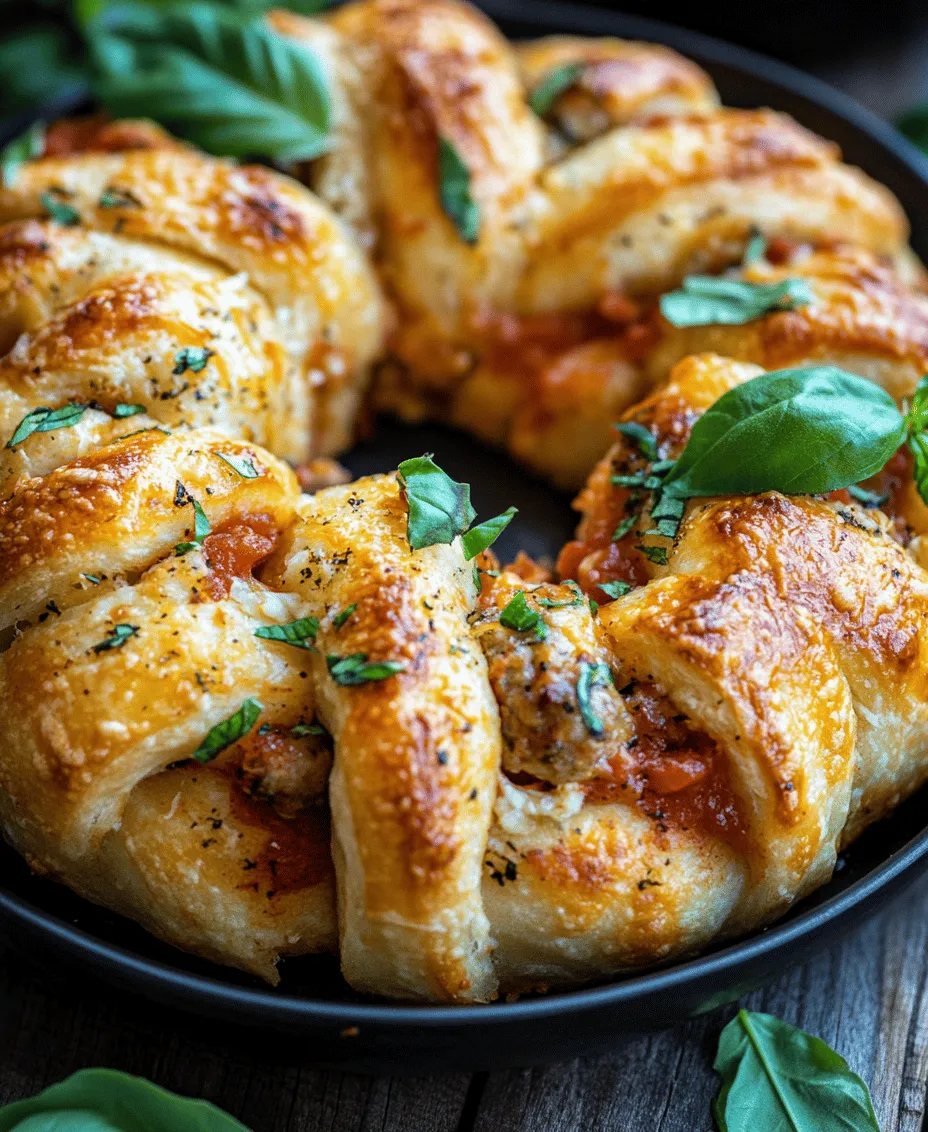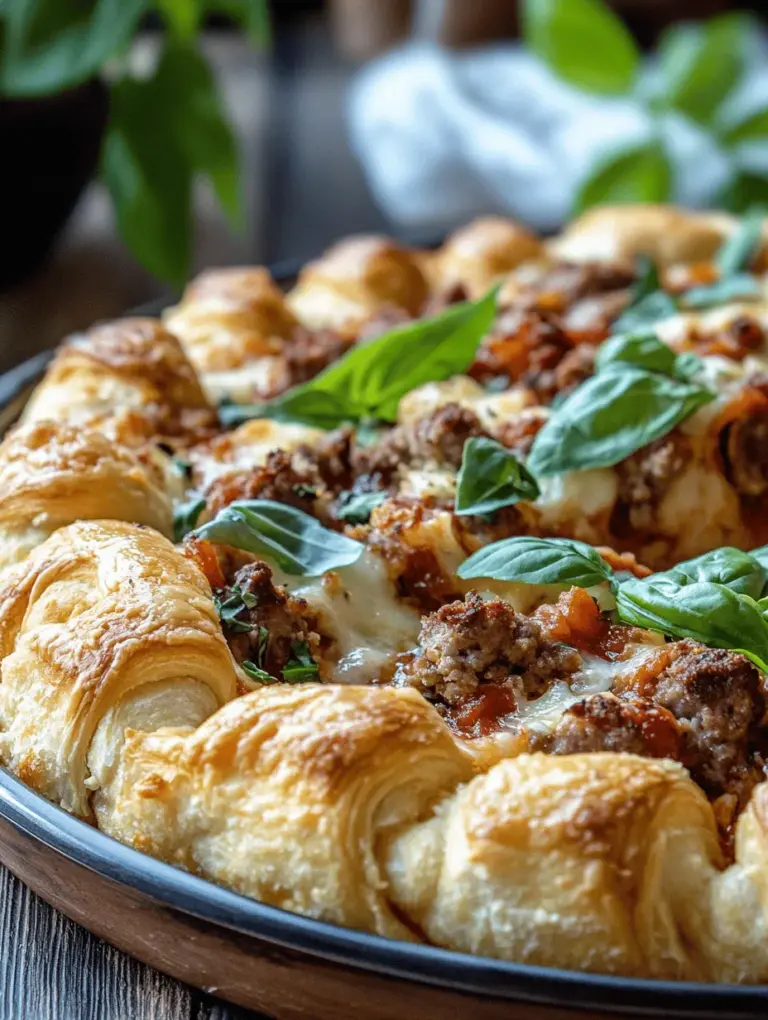Introduction
When it comes to comfort food that evokes the cozy warmth of family gatherings and hearty meals, few dishes can compete with the Italian Crescent Casserole. This delightful dish showcases the rich flavors of Italian cuisine while incorporating the ease of preparation that makes it perfect for weeknight dinners, potlucks, and festive occasions. The Italian Crescent Casserole combines the flaky goodness of crescent roll dough with savory ingredients, creating a meal that is not only delicious but incredibly satisfying.
This casserole is a brilliant fusion of flavors that highlight the essence of Italian cooking. The use of fresh ingredients, aromatic spices, and creamy textures makes it a standout dish that caters to both traditional Italian food lovers and those looking for something new. Whether you’re hosting a family dinner or simply craving a comforting meal, this casserole is sure to impress.
Understanding the Ingredients
The Star Ingredient: Crescent Roll Dough
At the heart of the Italian Crescent Casserole is the crescent roll dough, a versatile ingredient that lends both flavor and texture to the dish. Crescent roll dough is a pre-made pastry that is light, flaky, and buttery, making it an ideal base for both sweet and savory recipes. Its ability to rise and create a golden crust is essential for achieving the perfect texture in this casserole.
Crescent roll dough isn’t just limited to breakfast pastries; it can be creatively used in various savory dishes. From wraps to pinwheels, its adaptability means that it can be paired with a variety of fillings, making it a staple in many home kitchens. In the case of the Italian Crescent Casserole, the dough is layered over a hearty filling, baking into a delicious crust that envelops the flavorful ingredients beneath.
The Choice of Protein: Ground Italian Sausage
Another key ingredient that elevates this casserole is ground Italian sausage. Known for its robust flavor profile, Italian sausage is seasoned with a blend of spices, including fennel, garlic, and red pepper flakes. This seasoning not only enhances the taste of the meat but also infuses the entire dish with a warm, aromatic essence that is characteristic of Italian cooking.
When selecting your sausage, you have the option to choose between mild and spicy varieties, allowing you to tailor the heat level to your liking. The sausage is browned to perfection before being combined with other ingredients, ensuring that it remains juicy and flavorful. The richness of the sausage not only provides protein but also adds depth and heartiness to the casserole, making it a fulfilling meal for any occasion.
Importance of Fresh Vegetables
To balance the richness of the sausage and dough, fresh vegetables play a crucial role in this dish. Bell peppers and onions are commonly used in the Italian Crescent Casserole, not only for their vibrant colors but also for their flavor and texture. Bell peppers add a slight sweetness and crunch, while onions contribute a savory depth that enhances the overall taste.
Incorporating fresh vegetables into your meals is not only beneficial for flavor but also for nutrition. Bell peppers are rich in vitamins A and C, and onions provide antioxidants that contribute to overall health. By including these vegetables, the casserole becomes a well-rounded meal that nourishes both the body and the soul.
The Role of Marinara Sauce
No Italian dish would be complete without marinara sauce, and the Italian Crescent Casserole is no exception. Marinara sauce is a classic Italian tomato sauce that typically features tomatoes, garlic, herbs, and olive oil. Its rich, tangy flavor complements the savory elements of the casserole, tying all the ingredients together beautifully.
The marinara sauce not only adds moisture to the dish but also enhances the overall flavor profile. It brings a burst of acidity that balances the richness of the sausage and cheese, creating a harmonious blend of tastes. Moreover, the use of quality marinara sauce can elevate this casserole from ordinary to extraordinary, making it a true reflection of Italian culinary traditions.
Creamy Texture from Ricotta Cheese
Adding to the dish’s creaminess is ricotta cheese, which contributes a rich, velvety texture that takes the casserole to the next level. Ricotta is a staple in Italian cooking, known for its lightness and mild flavor. It complements the other ingredients without overpowering them, making it the perfect addition to this layered casserole.
Not only does ricotta add a creamy element, but it also provides protein and calcium, making the dish more nutritious. When baked, the ricotta melts into the filling, creating a luscious layer that binds the other components together. This creaminess is what makes the Italian Crescent Casserole so indulgent and satisfying.
The Essential Toppings: Mozzarella and Seasonings
To finish off the Italian Crescent Casserole, a generous layer of mozzarella cheese is sprinkled on top, creating a gooey, melted topping that is simply irresistible. Mozzarella is a beloved cheese in Italian cuisine, known for its stretchiness and mild flavor. It serves as a perfect contrast to the savory filling, adding another dimension of flavor and texture.
In addition to the mozzarella, various seasonings can be added to enhance the dish’s flavor further. A sprinkle of Italian seasoning, garlic powder, or crushed red pepper flakes can elevate the overall taste, making each bite a delightful experience. Choosing the right blend of seasonings is key to achieving an authentic Italian flavor that will have everyone coming back for seconds.
Preparation Steps Explained
Prepping the Oven and Baking Dish
Before diving into the cooking process, it’s essential to prepare your oven and baking dish for optimal results. Preheating the oven to the recommended temperature ensures that the casserole cooks evenly and thoroughly. A well-preheated oven allows the crescent roll dough to rise and become golden brown, creating that signature flaky texture.
In addition to preheating, greasing the baking dish is a crucial step that should not be overlooked. Using cooking spray or a light coating of olive oil will prevent the casserole from sticking, allowing for easy serving and clean-up. A properly greased dish will also enhance the browning of the dough, resulting in a visually appealing and delicious meal.
Cooking the Sausage Perfectly
The next step in preparing the Italian Crescent Casserole is cooking the ground Italian sausage. Start by heating a skillet over medium heat, then add the sausage, breaking it apart with a spatula. Allow it to brown evenly, stirring occasionally to ensure that all sides are cooked through.
Browning the sausage is important, as it develops a rich flavor through the Maillard reaction, which occurs when the meat is exposed to heat. Once the sausage is fully cooked, it’s essential to drain any excess fat. This can be done by carefully transferring the sausage to a plate lined with paper towels or using a colander to remove the grease. This step is vital for maintaining a balanced flavor in the casserole, preventing it from becoming overly greasy.
Sautéing Vegetables for Flavor
While the sausage is cooking, take the opportunity to sauté the fresh vegetables. In the same skillet, add diced bell peppers and onions, allowing them to soften and caramelize. Sautéing brings out the natural sweetness of the vegetables while enhancing their flavors, making them an integral part of the dish.
Cook the vegetables for about 5-7 minutes or until they become tender and fragrant. Combining the sautéed vegetables with the browned sausage will create a flavorful filling that forms the heart of the casserole. This mixture is then ready to be layered with the other ingredients, setting the stage for a delicious Italian feast.
By understanding the key ingredients and following these preparation steps, you’re well on your way to crafting a delectable Italian Crescent Casserole that your family and friends will love. Stay tuned for the next part, where we will delve deeper into assembling the casserole, baking it to perfection, and serving it up with flair.

The Significance of Cooking Vegetables to Enhance Their Sweetness
When preparing your Italian Crescent Casserole, the importance of cooking vegetables cannot be overstated. Cooking vegetables not only softens their texture but also enhances their natural sweetness, bringing out flavors that raw vegetables simply cannot match. For this recipe, we recommend sautéing onions, bell peppers, and any other vegetables you choose to use. This process caramelizes the sugars present in the vegetables, resulting in a delightful sweetness that elevates the overall flavor profile of the casserole. Additionally, sautéing helps to remove excess moisture, which is crucial for preventing a soggy casserole.
Combining Ingredients for the Filling
Once your vegetables are perfectly sautéed, it’s time to combine them with the other filling ingredients. In a large mixing bowl, combine your cooked vegetables with proteins such as Italian sausage or ground turkey, and your choice of cheese. A mixture of mozzarella and ricotta works beautifully for a creamy texture and rich flavor. Add in some Italian herbs such as oregano and basil to infuse the filling with authenticity.
For a more balanced filling, consider adding a handful of fresh spinach or kale. These leafy greens wilt down nicely and add a dose of nutrients to your dish without overwhelming the other flavors. Mix all the ingredients thoroughly until well-combined. This step is vital for ensuring that every bite of your casserole is packed with flavor.
How to Ensure a Well-Blended and Flavorful Mixture
To achieve a well-blended and flavorful mixture, ensure that all ingredients are at room temperature before combining. This ensures that the cheeses blend more smoothly and the flavors meld together. Use a spatula to fold the ingredients gently, allowing the moisture from the ricotta to bind everything together without breaking the vegetables apart. Taste your mixture and adjust the seasoning as needed; a pinch of salt or a dash of pepper can make a significant difference.
Layering Techniques with Crescent Roll Dough
Layering is crucial for achieving that perfect texture in your Italian Crescent Casserole. Start by preheating your oven to 375°F (190°C) while you prepare your dish. For the crescent roll dough, carefully unroll the first package and lay it at the bottom of a greased 9×13 inch baking dish. Be sure to pinch the seams together where the dough connects to create a solid base for your filling.
Next, add a generous layer of your prepared filling on top of the crescent dough. Spread it evenly, ensuring each corner is filled with the delicious mixture. The second package of crescent roll dough is used to create a top layer. You can either lay it out whole or cut it into strips for a more rustic look. If you opt for strips, weave them over the filling for a charming lattice effect, which not only looks appealing but also allows the filling to peek through.
Detailed Instructions on How to Properly Layer the Dough for Optimal Texture
1. Prepare Your Baking Dish: Grease the 9×13 inch baking dish with cooking spray or butter to prevent sticking.
2. First Layer: Unroll the first package of crescent roll dough and lay it flat in the dish. Pinch the seams together to create a solid crust.
3. Add the Filling: Spoon the vegetable and cheese mixture evenly over the dough, ensuring it reaches all edges of the dish.
4. Top Layer: Unroll the second package of crescent dough. If you prefer, cut the dough into strips and create a lattice pattern over the filling. Alternatively, you can lay it flat like the bottom layer.
5. Seal the Edges: Use your fingers to pinch the edges of the top layer to the bottom layer, sealing in the filling.
Baking the Casserole to Perfection
With your casserole assembled, it’s time to bake! Place the dish in the preheated oven and bake for 25-30 minutes or until the top is golden brown and the filling is bubbling. Keep an eye on it during the last few minutes—ovens can vary in temperature, and you want to avoid over-baking which can lead to a dry casserole.
Tips on Baking Times and Temperature for Achieving Golden-Brown Crust
– Temperature: Maintaining the oven temperature at 375°F (190°C) is ideal for cooking the casserole evenly without burning the top.
– Cover with Foil: If the top is browning too quickly, loosely cover the casserole with aluminum foil to prevent burning while allowing the filling to cook through.
– Check for Doneness: Use a toothpick inserted into the center to check if the filling is heated through. If it comes out clean, your casserole is ready!
Serving Suggestions
Creative Ways to Serve the Italian Crescent Casserole
The Italian Crescent Casserole is not just a dish; it’s a centerpiece for any meal. Once baked and slightly cooled, slice the casserole into squares and serve it warm. For an added touch, garnish with fresh basil or a sprinkle of Parmesan cheese before serving.
Pairing Ideas
– Salads: A fresh arugula salad with lemon vinaigrette complements the richness of the casserole perfectly. The peppery greens balance the flavors and add a refreshing crunch.
– Sides: Serve with garlic bread or a side of roasted vegetables. These choices enhance the Italian theme while providing a delicious contrast in textures.
– Beverages: Pair your meal with a crisp white wine, such as Pinot Grigio, or a light sparkling water with a slice of lemon for a refreshing drink that cleanses the palate.
Presentation Tips
To plate the casserole beautifully for gatherings, consider the following:
– Garnishing: Add vibrant colors by garnishing with fresh herbs or a drizzle of balsamic reduction.
– Serving Dish: Use a colorful or rustic serving dish to add an element of charm to your table setting.
– Cutting Evenly: For neat slices, use a sharp knife and let the casserole rest for a few minutes before cutting. This ensures that the layers hold together better.
Possible Variations
Vegetarian Options or Alternative Proteins
If you’re looking for a vegetarian option, substitute the meat with chickpeas or lentils for added protein. You can also include a variety of vegetables such as zucchini, mushrooms, or eggplant to create a delicious medley.
Different Cheese Combinations for Unique Flavors
Experimenting with various cheese combinations can drastically change the flavor of your casserole. Try using feta for a tangy twist or smoked mozzarella for a rich, smoky flavor. Mixing in goat cheese can also add a creamy texture and a unique taste that pairs well with the casserole’s overall profile.
Nutritional Information
Understanding the nutritional content of your Italian Crescent Casserole can help you make informed choices.
– Calories: Approximately 350 calories per serving, depending on the specific ingredients used.
– Protein: About 20 grams of protein per serving, primarily from the cheese and meat components.
– Fats: Roughly 22 grams of fat, which can be reduced by opting for low-fat cheese options or leaner meats.
– Carbohydrates: Around 30 grams of carbohydrates, mainly from the crescent roll dough.
Discussion on Making Healthier Substitutions
To make the casserole lighter, consider using low-fat cheese or turkey sausage instead of traditional sausage. You can also opt for whole wheat crescent rolls for a healthier base that adds fiber to your meal. Don’t hesitate to add more vegetables to increase the nutrient density without significantly altering the flavor.
Conclusion
The Italian Crescent Casserole is more than just a casserole; it’s a celebration of flavors that brings comfort to your table. Easy to prepare and perfect for feeding a crowd, this dish allows for endless customization. Whether you stick to the original recipe or experiment with your favorite ingredients, this casserole guarantees satisfaction.
As you venture into the world of cooking, remember that the best meals come from sharing your creativity with family and friends. Embrace the process, have fun in the kitchen, and enjoy the delightful experience of homemade comfort food. So gather your loved ones, serve up this delicious Italian Crescent Casserole, and create memories that will last a lifetime.

